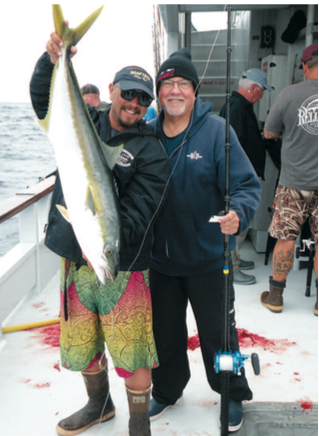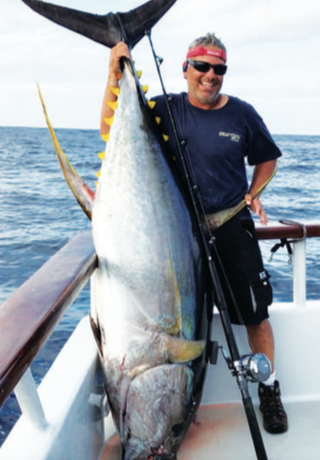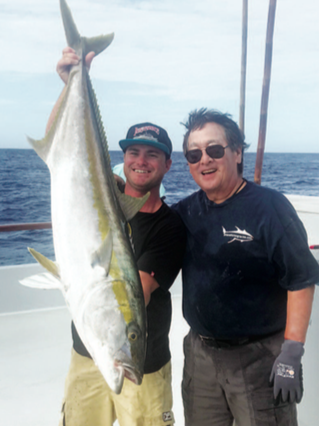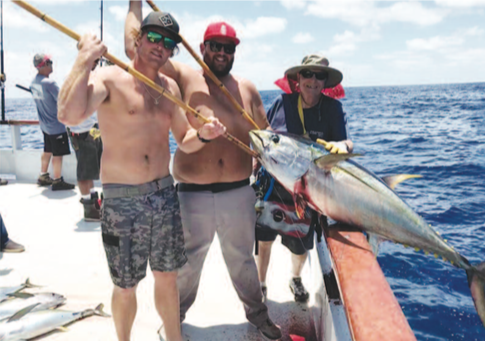SAN DIEGO – Rick Ozaki is well-known in the sportfishing community primarily for his time spent working with huge fishing brands and his years hosting long range trips. He has worked as a manager, designer and rep for household names in the industry including Big 5 Sporting Goods, Calstar rods, Avet reels, Tady, and he has since pioneered his own brand, Graftech Rods. Amongst these professional pursuits, Ozaki has spent much of his free time as a chartermaster on long range fishing trips ranging from 3 days to longer 17-day trips fishing exotic destinations. When asked how many trips we are talking about, Ozaki said he has hosted between 50 and 60 trips from 16 to 18 days and nearly double that for 5- to 10- day trips.
Ozaki was kind enough to offer some of his opinions, experience and advice on entering the long range fishing arena. His first long range trips fished in the late ‘80s. Back then, fishing conditions were totally different including available destinations and targeted species. Guadalupe Island offered giant bluefin tuna on anchor, there were huge yellowtail at Cedros Island and albacore and other pelagics were offshore.
Over the years, the zones have changed. Some fishing opportunities have been closed off or seemingly disappeared, while others have exploded and come closer to home. Between the changing conditions, available destinations and huge technological developments in gear, the long range fleet has continuously honed their techniques and evolved accordingly. On that note, with the great fishing opportunities present over the last few years it has proved difficult to even get on a long range boat. Booking in advance is essential.
Long Range vs. Short Range
For sake of a simple definition, a short-range trip is a trip under 3 days and long range is over 3 days. Ozaki prefers fishing long range trips as, “They allow anglers to spend more days in fishy areas, experience more opportunities to catch big fish, but above that, anglers can experience camaraderie which is unmatched. Anglers have the opportunity to check out from the daily stresses and play poker, eat great food, drink beers, set up tackle and talk fishing with friends.”

He added that on his trips, he gets to see many friends whom he has fished with for over 20 years.
The learning curve for catching huge tuna is also reduced on longer trips. Ozaki said he has seen many anglers on their first long range fishing trip catch a cow tuna. Whether it is for local bluefin or yellowfin down below, long range trips typically allow anglers to try more fishing methods to dial in the bite. For cow yellowfin in the winter, anglers are able to try fishing the kite, fly-lining live skipjack, fishing chunked tuna, sinker rigs and more in a single trip. For bluefin, anglers may get to also fish the kite, fly-line live baits, sinker rig baits and fish knife/Flat-Fall-style jigs at night. The longer trips also offer more opportunities to catch the fish off-guard in a biting mood.
Winter Trips
During the winter, the long-range fleet offers longer trips that chase huge yellowfin tuna with a side of wahoo. They must travel far to find ideal conditions, and these are the lengthy trips that range from 13 to 17 days. Ozaki’s annual winter trip usually fishes in either March or April as a 16-day trip. The longer duration allows them to run the distance to Hurricane Bank and surrounding zones, which takes approximately four days each way departing from San Diego. At these spots, they fish both on anchor and while drifting.
Some trips score better than others, and 2021 was a relatively slow year for the large yellowfin at these spots. However, some trips had stellar wahoo fishing. Nowadays, the fleet is more limited in where they can fish, as some of the popular destinations from the past have been closed, places like Clarion, Socorro, Roco Partida and others. However, the opportunity at great fishing is still available this time of year.

Ozaki recalls a time in the early 2000s when cow fishing for numbers really started. He’d been fishing long range trips for just over 10 years before claiming his first cow on a trip fishing the Hurricane Bank. Back then, Ozaki explained it was a goal and accomplishment for a boat to catch a single cow tuna. This is contrasted by trips since, where individual boats have put the hurting to more than 50 cow tuna in a single trip, and anglers have had real shots at getting double digits of cow fish singlehandedly.
The last couple years of winter fishing have been on the tougher side, Ozaki added. He said there have been more sharks and less favorable conditions in terms of current, bait and others. On his 2021 winter 16-day, the group caught pretty good numbers of wahoo at Hurricane Bank, however, they only caught one cow yellowfin on the kite. There are exotic species at the Bank, too, like “Chopas,” (aka Black Jacks) rainbow runners, jack crevalle and other unique stuff. Sometimes the small yellowfin tuna build around the boat pretty good, which makes for fun catching and these smaller fish can also be chunked up for bait. This is a long range secret to avoid catching skipjack and some other junky fish and dial in on the targeted larger yellowfin. Much of the fishing available on these trips is pretty undocumented in mainstream media, known intimately only by the captains, crew and passengers who have fished them.
Summer and Fall

Between the months of June and October, more medium-duration trips of 7 to 8 days are commonplace. Amongst regulars, this season is well known for mixed-bag fishing. The last few years, these trips have hit local bluefin as well as southern areas off of coastal Baja for warm-water exotics. These lower zones off Baja include the famous Alijos Rocks and Alijos Bank a couple hundred miles offshore, along with “the Ridge,” a series of offshore spots closer to Baja Mexico proper. The variety of fish which are caught on these trips make them very attractive and in recent years, tough to find a ticket for.
Fishing for bluefin tuna can occur either on the way to or from the lower zone, depending on the location of the fish. Anglers can fish bluefin in style with more rail space, long range-quality food and comfort and with expert facilitation of seasoned captains and crew. The longer trips are almost sure to give a look at night fishing with jigs, which has accounted for many big bluefin taken in recent years.
Farther down the line, boats often make a beeline to Alijos Rocks where wahoo are the most frequent target. They’re taken by trolling, fly-lined baits and casting specialty wahoo jigs and “bombs.” Nearby, Alijos Banks, aka the “42,” offers fishing for giant yellowtail and sometimes gulf grouper. Ozaki’s 8-day in June of 2020 had standout grouper fishing, boating a total of 35! These bigger yellows and grouper are usually fished for with heavy dropper loop set-ups with 100-pound line the recommended way to go. Ozaki fishes his dropper-loop in low gear to horse the fish in. When he’s bit, he will wind relentlessly and the torque from the low-gear brings the fish right up. A single moment of hesitation in higher gear allows the fish to dig into a crevice, reef or rock and ruin your day.
At the Ridge, a pretty expansive offshore zone, anglers usually fish for numbers of yellowtail and school-grade yellowfin tuna. After taking a shot at the bigger Alijos Bank brutes, anglers will get a shot at filling their quota of yellows for the trip. Often up and chasing around chum, this destination as a lure-thrower’s dream. Surface iron, poppers, yo- yo iron and other fan favorites came up in the conversation and days with boats catching hundreds of fish are commonplace. School-grade yellowfin tuna willingly bite fly-lined baits and lures. Sometimes though, anglers will have to adapt techniques and weed through skipjack tuna to get their desired catch of yellowfin.
Rick’s Favorite Boat /Independence
Ozaki made note of the fantastic opportunities available amongst the entire long range fleet. He’s had fantastic times aboard the Excel, Red Rooster III and others. Some boats are bigger, smaller, lower to the water and other physical variables. Then there are characteristics like maximum capacity load, special fishing permits, fly- down trips, etc. With all factors considered, Ozaki ranks the vessel Independence as his favorite overall long range boat.
A major factor influencing Ozaki’s opinion is the riding comfort of the boat. Ozaki explains his opinion that, “The best riding boat in the fleet is the Indy. It’s extremely wide and it doesn’t rock much due to being bottom-heavy with a steel hull and an aluminum house. On the way down, you’re typically going with the wind and swell and it’s very comfortable. It’s time to kick back, settle down, hang out for the fishing and safety seminars and slowly begin rigging up rods.”
He commented further on the amenities and creature comforts of the boat. Ozaki isn’t a big meat-eater, more chicken, but the only time he will eat meat is prime rib on the Indy. It’s too good to miss. The crew knows what he likes and are glad to offer him chicken on other days. So, customized food requests are available, but Ozaki recommended talking to the office in advance about any dietary restrictions or requests.
The boat offers relative ease of access to long range fishing for folks from out of state or newbies. Available at no additional cost are rod-and-reel set-ups through the boat’s office on a first-come, first-serve basis. Further, Ozaki mentioned that many terminal tackle items like hooks, sinkers, leader material, bulk spools of monofilament and other basics are available on the boat. It’s a good idea to check with the landing well before a scheduled trip, though.
Finally, Rick has known owner-operators Paul Strasser and Mark Pisano for many years. For some time, they were the among the youngest captains in the fleet, hungry to catch and running a tight ship. Ozaki’s favorite memory aboard the Indy came from a winter trip fishing cow yellowfin tuna. He recalls fondly, it was 2006 on Rick’s longer winter charter with Capt. Pisano at the helm in the vicinity of the Hurricane Bank. When all was said and done, they boated over 80 cows over several days of incredible fishing on all techniques. Ozaki claims now the crew is as great as ever, and he enjoys fishing with the “newer,” captains Brian Pifer and Matt Kaulen.
Tips and Tricks
• If Rick were to suggest four set-ups to bring on any modern long range trip, they’d be outfits for a 30- to 40-pound line, 50- to 60-pound, a 60 to 80 outfit and a 100- to 130-pound set-up. Braided line with a 30-foot fluorocarbon leaders is how Ozaki gets after it.
• If anglers need gear, try getting on a manufacturer-sponsored trip or find a boat that offers rental gear.
• For anglers who don’t want to keep their fish, it’s not usually hard to find anglers aboard the boat who will willingly add your fish to their limit. Otherwise, fish processors can also be of assistance in sourcing a charitable recipient of your sport-caught fish.



